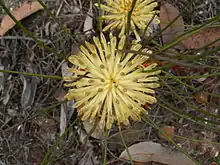| Long-leaved cone bush | |
|---|---|
 | |
| P. longifolia in the Stirling Range. | |
| Scientific classification | |
| Kingdom: | Plantae |
| Clade: | Tracheophytes |
| Clade: | Angiosperms |
| Clade: | Eudicots |
| Order: | Proteales |
| Family: | Proteaceae |
| Genus: | Petrophile |
| Species: | P. longifolia |
| Binomial name | |
| Petrophile longifolia | |
Petrophile longifolia, commonly known as the long-leaved cone bush is a shrub which is native to the south west of Western Australia, growing between the city of Albany and the Stirling Range.[1]
Description
Petrophile longifolia is a ground-hugging shrub without a lignotuber, but with short stems and long (20–40 cm), thin cylindrical leaves with a sharp-pointed end. The flower heads are silky, cream in colour, 4–6 cm across, at the ends of short branches and surrounded by many short, pointed, leaf-like bracts. The flowers appear in late spring and early summer and are followed by long, oval-shaped fruits which, like others of the genus, only release their seeds after a fire or the death of the plant.[2][3]
Taxonomy and naming
Petrophile longifolia was first formally described in 1830 by Robert Brown from a specimen collected in 1829 near King George Sound by William Baxter. The description was published in Supplementum primum Prodromi florae Novae Hollandiae[4] The specific epithet (longifolia) is derived from the Latin words longus meaning "long" and folium meaning "leaf".[5]
Distribution and habitat
Long-leaved cone bush is found in the Esperance Plains, Jarrah forest, Swan Coastal Plain and Warren biogeographical regions.[6] It grows in sand, gravel, sandy loam or clay on sandplains.[7]
Cultivation
Petrophile longifolia, like others of its genus is not often cultivated but although it is a western species, is more reliable in humid east coast gardens than many others. It performs best in areas with dry summers and well drained soils in a sunny position.[3]
Conservation status
Petrophile longifolia is not threatened at present.[7]
References
- ↑ "Petrophile longifolia". FloraBase. Western Australian Government Department of Biodiversity, Conservation and Attractions. Retrieved 21 February 2015
- ↑ Erickson, Rica; George, Alex; Marchant, Neville; Morcombe, Michael (1982). Flowers and plants of Western Australia (Repr. ed.). Sydney: Reed. p. 61. ISBN 058950116X.
- 1 2 "Petrophile longifolia". Australian native plant society (Australia). Retrieved 21 February 2015.
- ↑ "Petrophile longifoliaR.Br". Australian Plant Name Index (APNI), IBIS database. Centre for Plant Biodiversity Research, Australian Government.
- ↑ Backer, C.A. (1936). Verklarend woordenboek der wetenschappelijke namen van de in Nederland en Nederlandsch-Indië in het wild groeiende en in tuinen en parken gekweekte varens en hoogere planten (Edition Nicoline van der Sijs).
- ↑ Paczkowska, Grazyna; Chapman, Alex R. (2000). The Western Australian flora : a descriptive catalogue. Perth: Wildflower Society of Western Australia. p. 500. ISBN 0646401009.
- 1 2 "Petrophile longifoliaR.Br". FloraBase. Western Australian Government Department of Biodiversity, Conservation and Attractions.